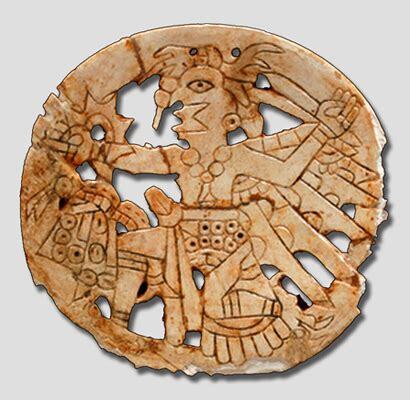Ancient Mississippian Civilization

Episode 12: Wider Mississippian Culture
Ancient Civilizations of North America
Dr Edwin Barnhart (2018)
Film Review
This lecture concerns the spread of Mississippian culture following the fall of Cahokia (see Human Sacrifice in the Mississippian City of Cahokia). By 1000 AD, Mississippian civilization encompassed millions of people with shared religious beliefs and artistic expression. The introduction of corn (between 900-1000 AD) led to armed conflict between villages (apparent from skeletons revealing violent deaths and the appearance of palisades and other military fortifications around 1000 AD on).
David Graeber and David Wengrow comment on this in the The Dawn of Everything. As they point out, the absence of food surpluses in hunter gatherer societies gave neighboring villages no incentive to instigate violence to steal them.
Barnhart divides what he calls Southeast Ceremonial Complex art into five periods:
The Developmental Cult Period 900 – 1150 AD (characterized by crossed circles, long nosed gods and swastikas)The Southern Cult Period 1250 – 1350 AD (characterized by bilobed arrows, striped poles, chunkey players, piazzas and birds of prey)The Attenuated Cult Period 1350 – 1450 AD (in which trade networks beak down and artifacts are based on local materials and themes)The Post-Southern Cult Period 1450 – 1550 AD (characterized by a big increase in regional diversity.Historic Period 1550 – present (in which European colonization leads to breakdown of Mississippian civilization).Post-Cahokia Mississippian civilization saw the development of numerous thriving villages throughout eastern North America modeled on Cahokia and participating in wide trade networks, resulting in numerous religious artifacts made from imported materials, such as mica, copper, shell and ceramics.
Specific settlements Barnhart describes include
Aztalan (Wisconsin) 900-1250 AD – a mound building village covering 35 acres, with a central plaza that featured both circular houses (like Cahokia) and rectangular houses (similar to Hopewell culture). Archeological remains indicate residents grew corn, squash, gourds and sunflowers hunted dear, played chunkey* and engaged in extensive trade with other Mississippian communities.Kay-Nah-Chi-Wah-Nung (Ontario – aka Manitou Mounds) – name means “place of the long rapids.” This allowed for year round fishing because rapids don’t freeze. Contains Mississippian burial mounds dating from both the Laurel (300 BC – 1100 AD) and the Blackduck (800-1650 AD) cultures.Tabor Hill (Toronto) – believed to date from the 14th century AD.Moundville (Alabama) – 1100 – 1450 AD – second largest city north of Mexico, becoming the largest after Cahokia’s collapse. Had a clear three tiered social structure, consisting of a chief class (less than 10 people), an elite class and commoners.Spiro Mounds (Oklahoma) 850-1450 AD – only Mississippian village west of the Mississippi river. Very similar layout to Cahokia, with chunkey court and central plaza surrounded by mounds.Around 1375 AD, all Mississippian villages experienced a big drop in population as people migrated to more rural settings.
Graeber and Wengrow also comment on this population shift (page 491) after Cahokia:
“The overall direction in the wake of Cahokia was a broad movement away from overlords of any kind and constitutional structures carefully worked out to distribute power in such a way they could never return.”
*Chunkey was a Mississippian game in which players rolled flat disk-like stones and other players threw spears at them.
Film can be viewed free with library card on Kanopy.
The Most Revolutionary Act
- Stuart Jeanne Bramhall's profile
- 11 followers



